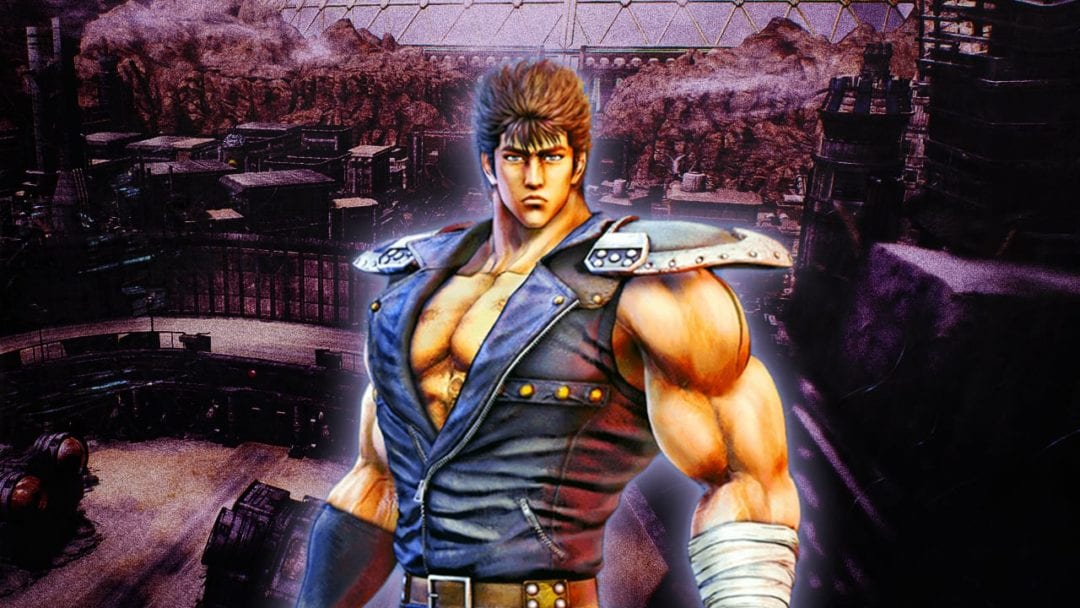Fist of the North Star: Lost Paradise knocked me right out of its passionately 1980s post-apocalyptic wasteland in the first five minutes. Even before the tutorial was through teaching me how to make pink mohawked muscle bros explode just by touching them — which is, I’ve discovered, the vintage anime series’ raison d’etre — my immersion was broken as soon as Takaya Kuroda’s voice came growling out of the lead character’s mouth. That’s Kazuma Kiryu, hero of Yakuza’s voice damn it. How am I supposed to take this beefcake and his spiked shoulder pads and his eight-mile-long biker boots seriously when old Kiryu-chan’s voice is coming out of him! That would be ridiculous.
Then, just as quickly, I settled into Fist’s landscape of torn jeans and brutal martial arts. It wasn’t just Kazuma Kiryu’s voice carried over from Yakuza; it was everything: the staccato rhythm of the one-on-a dozen fights, the city full of small errands and diversions to explore, even the stylized “S” over save points. As though a whole series of games dressed up for Halloween, the Ryu Ga Gotoku studio behind both Fist and Yakuza draped the icons of another pop dynasty over its own, tweaked the formula just slightly, and called it a day. Rather than come off as lazy, the effect is effervescent. Familiarity doesn’t breed (lasting) contempt in Fist of the North Star, but comfort and ease to a player steeped in the games it’s based on.
There’s a replicable lesson for other creators: don’t be afraid to copy yourself.
In carrying the structure, combat basics, and even performers over from its previous work, the Ryu Ga Gotoku studio effectively takes out the first date element from Fist. Rather than struggling to create a whole new formula and technology for a game license Sega acquired, it adjusted its own proven formula and focused on refining the aesthetics and smaller action tweaks to suit that license.
In Fist of the North Star, it’s actually charming to see new flourishes on elements that have been established over nearly a dozen titles stretching back to PS2. Kenshiro’s pressure point finishing moves that make enemies literally explode into piles of goop versus the over-the-top curb stomps Kazuma doles out (and which his enemies inexplicably survive); exaggerated, bulky caricatures versus vividly captured human characters; starkly lit desert versus neon city streets — everything is a little different, but the bones beneath are the same.
What the Ryu Ga Gotoku Studio has done here isn’t unique, just very tricky to do well. Infinite Interactive’s Puzzle Quest expertly blended match-three puzzle games with sword-and-sorcery role-playing back in 2007. As multiple licenses got thrown on top of it, though, it became clear that once you’d played a single Puzzle Quest game, you’d played them all, regardless of whether the Avengers, Magic: The Gathering, or Adventure Time characters popped up in the menus. There wasn’t enough room for differentiation.
Omega Force, meanwhile, has built its own cottage industry on reusing the basics of its most famous creation. The studio behind the seemingly immortal Dynasty Warriors series has spent the past decade partnering with everyone from Gundam owners Sunrise Inc. to Nintendo giving their properties the Warriors treatment to spectacular effect. All of Omega Force’s games share the same essentials: select a champion from a deep bench of characters, send them out into a battlefield where they single-handedly down hundreds of soldiers to gain ground, unlock booty, then watch some light melodrama. What’s made Omega Force’s formula so successful, though, is how malleable those stock parts have proven to be. The gaudy, delightful histrionics of Dynasty Warriors are warped into thrilling kinetics in Omega’s Attack on Titan games by adding speedy grappling hooks to the combat. Both feel distinct from the light dating sim fun in Fire Emblem Warriors or the deep lore mashup pleasure of Gundam Warriors. And all of their games are visually distinct from one another, using the source material of each property to create new play spaces that feel totally familiar and welcoming while being feeling aesthetically fresh.
That freshness is important. Audiences are fickle. Just look at the emotional roller coaster I went through playing Fist of the North Star for the first time. There’s as much risk in reusing your successful work as there is opportunity. Ubisoft’s relentless production of open world games over the past decade has yielded some massive critical and commercial successes like Far Cry 3 and Assassin’s Creed IV: Black Flag, but it’s also resulted in the dilution of those games’ unique identities. Far Cry, Assassin’s Creed, and Watch Dogs became interchangeable to the point that Assassin’s Creed basically had to be reinvented as an entirely different game focused more on story and role-playing. Far Cry Primal got savaged for lifting Far Cry 4’s map precisely even though it took some charismatic aesthetic risks. Too much copying and it doesn’t matter how novel cavemen are. Familiarity can lead to contempt after all.
Fist of the North Star: Lost Paradise is a charmer, though, changing up Yakuza’s alchemical blend with its source material enough to make the whole thing feel equally cozy and new. The studio has an even more ambitious riff on the blueprint coming next year in Judge Eyes. Like a Takashi Mieke adaptation of a John Grisham novel, Judge Eyes trades in Yakuza’s mob theatrics for a legal drama murder mystery. But the whole thing will take place in Kamurocho, the very same fictional city featured in every Yakuza game. Whether or not the copying gambit will keep working for the Ryu Ga Gotoku Studio depends on how flexible its model proves to be as it’s strained by more projects.






Published: Oct 5, 2018 04:00 pm